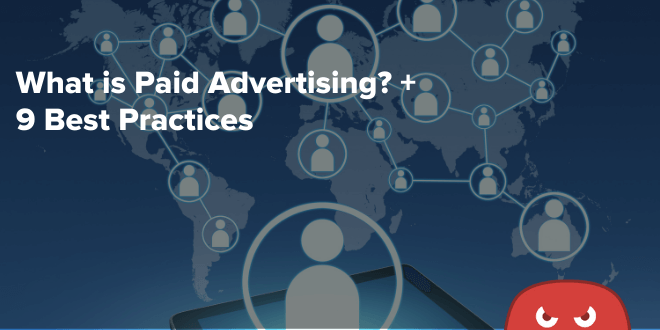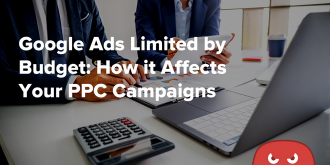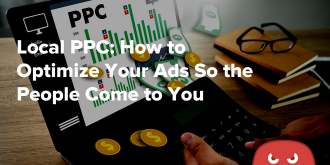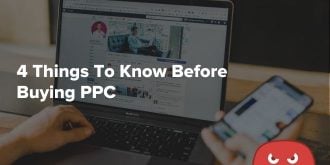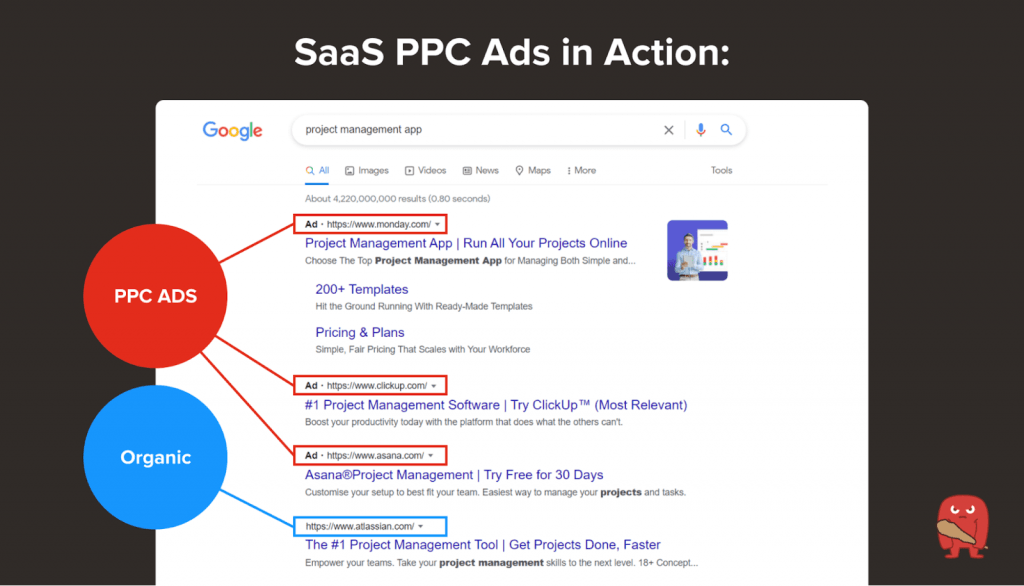Quick Links
Do you want to reach potential customers, build awareness of your brand, and make more sales?
Of course you do!
The good news is that there’s an easy way to do this. You can invest in paid advertising like search ads or ads on social media.
But a lot of businesses are wary about getting started with paid advertising (or expanding their ad budget). After all, a small business doesn’t have a big budget to waste.
Is paid advertising really worth it? Where should you advertise? And how do you create effective paid ads, anyway?
We’re here to answer those questions and more. This article introduces paid advertising, the major types of ads, and how you can get the most for your ad spend.
What is Paid Advertising?
Paid advertising can take many forms, but it typically involves paying a publisher or ad platform for every time someone views or clicks your ad.
What is PPC?
Unlike paid media, which refers to all types of advertising from newspapers to the web, when marketers talk about paid advertising, they usually mean digital PPC ads.
PPC stands for pay-per-click. Pay-per-click advertising is just what it sounds like: you pay for every click you get. You can usually sign up for the ad platform — like Google Ads or Facebook Ads — for free. Whenever a user clicks your ad, you pay a set amount.
PPC ads are one of the easiest and most effective ways to drive traffic to your website and convert prospects into customers.
What Are the Benefits of Paid Advertising?
Paid advertising is easy to start, but it costs money and it takes time to master. So why should you bother with it? There are many good reasons.
Paid advertising has a good ROI
Paid ads work. 74% of brands and 79% of agencies say that PPC is a huge driver for their business.
And you don’t have to pay a lot to get started. Paid advertising works with any budget — you can spend $50 per month or $50,000.
Your individual results will depend on how well you optimize your ad campaigns, as well as other factors, but it’s possible to see an excellent return on investment. For an idea of what ROI you can expect, check out our free PPC ROI calculator.
Advertising builds brand awareness
Ads are great for putting your brand in front of more eyeballs. Paid advertising can expand your reach, connecting you with people who have never heard of you and that you can’t reach with other forms of marketing.
PPC is easy to track and analyze
Sometimes it’s hard to know if your marketing efforts are paying off. Not so with PPC. It’s easy to track, evaluate, and optimize ads.
This helps you calculate advertising ROI, and you can also learn about your audience. For example, you might find that ads based on a particular keyword earn the most conversions. You now know the keyword resonates with potential customers and can use it in SEO and other campaigns.
Unmatched targeting
You can exclusively target hot prospects as they’re searching for keywords directly related to specific products or services you offer. Or, you can target someone with an online profile similar to your existing customer base.
Digital paid advertising offers targeting options in real time that no traditional media can match.
What Are Some Examples of Paid Advertising?
These days, paid ads are everywhere — on the search engines we use, the websites we read, the videos we watch, and more.
If you’re looking to get into paid advertising, you have a lot of options. These are some of the most common.
Search ads
When you type a search term into Google or Bing, what comes up first? In most cases, it’s not an organic search result, but an ad.
By targeting certain keywords, your ads can show at the top of relevant SERPs (search engine results pages) as well. Google Ads is the clear market leader, but Bing, Yahoo, and some smaller search engines offer search ads as well.
Because of their powerful targeting options, search ads are the most popular paid advertising format.
Display ads
Display ads are visual ads combining images or videos and text. They display on a variety of websites and can be aimed at building brand awareness or driving traffic to a website.
The usual way to advertise with display ads is to sign up for a platform like Google Ads. Your ads will then be displayed on the many websites within the Google network.
Social media ads
Social media platforms are an important place to promote your business. 51% of consumers say their purchasing decisions are influenced by social media.
The details vary from one platform to the next, but all of the major social media sites offer paid advertising.
Retargeting
You’ve probably experienced it — you look at a product website only to have ads for that product follow you around the internet for weeks.
This type of ad campaign is called retargeting, and you can do it too. Many ad platforms offer retargeting — including Facebook Ads and Google Ads. Some retargeting ads are based on website visitors, while others target visitors to your social media page or people on your contact list.
Influencer marketing
Working with influencers can also be a type of paid advertising. This typically involves paying influencers to create sponsored content about your business.
Affiliate marketing
An affiliate (also called an affiliate marketer) is someone who promotes your brand on their website, social media, or email list. The affiliate gets paid when their promotion leads to a sale.
For example, maybe the affiliate runs a successful blog. They write a blog post about your product that links to your website. Every time someone clicks the link and subsequently makes a purchase, the affiliate marketer gets a commission.
What Are the Best Paid Advertising Networks?
Not sure where to go to get started with paid advertising? Try one of these top ad platforms.
Google Ads
Google Ads is famous for its search ads because they offer a unique chance to appear above organic search results for important search terms.
But that’s not all it has to offer.
Other ad formats include:
- Display ads
- Video ads (ads shown on YouTube and other video websites)
- App ads (ads to drive app installs, engagements, and signups)
- Shopping ads (ads to promote online and local inventory at the top of the SERP)
- Local ads (ads to entice people to physical stores and venues)
Facebook Ads
Google and Facebook are currently the most popular PPC networks.
Facebook Ads appear around the Facebook network, including in Facebook and Instagram feeds, Facebook Marketplace, Facebook Messenger, and more. Some ads appear outside of Facebook-owned apps on websites in the Facebook Audience Network.
Microsoft Ads
The Microsoft Ads network lets you create search ads on Bing, Yahoo, and AOL, as well as ads that appear on other sites in the Microsoft network.
Microsoft doesn’t have the reach that Google does, but one upside of that is the lower competition and, often, lower cost-per-click for similar keywords.
Other social media ads
Instagram, LinkedIn, TikTok, Pinterest, and other social media platforms all offer ads.
Which one will work best for your business depends on your audience. For example, a B2B brand might do well on LinkedIn, whereas one aimed at younger consumers could consider TikTok.
9 Top Online Advertising Best Practices
Paid advertising has the potential to earn an impressive ROI — but you have to do it right. Follow these nine best practices for the best results.
1. Define your goal
Before you even decide which ad platform to use, you should know what you want to accomplish with your ads.
For example, are you more interested in expanding your reach or getting the most cost-effective conversions?
To drive sales, you might choose search or shopping ads, while display or video ads could be used to build brand awareness. The content and targeting of your ads will also be determined by your goals.
2. Know your ad types
Each ad platform offers a variety of ad types, some more well-known than others. For example, you’ve probably seen the standard Google search ad with a link to the brand’s website.
But what if your goal isn’t to bring people to your website but to get them to call your business? In that case, you can use a call-only ad. These ads display to mobile users and let them click your ad to call you directly from the search page.
Before you start creating advertising campaigns on any platform, it’s important to understand the available ad formats. If you don’t do your research, you might end up using an ad type that doesn’t fit your goals.
3. Create hyper-targeted audiences
When asked about their biggest digital advertising challenge in 2021, 24.6% of advertisers said it was “finding proper targeting.”
Targeting may not be easy, but it’s essential. Accurate targeting increases the chances that your ad will resonate with its audience, which in turn increases the chances that viewers of the ad will click on it and even convert.
Hyper-targeting means that each ad is highly customized to a specific audience. If your business sells outdoor gear, you don’t just show the same search ad copy to everyone — you show one ad to young cycling enthusiasts and a different one to middle-aged skiers.
To get expert help with targeting and other top PPC challenges, try our PPC management services.
4. Build optimized landing pages
Most types of paid ads will link to your website. The page you link to is as important as the copy on the ad.
To understand why, imagine this: someone typed “cost of custom neon sign” into Google. The first ad on the SERP is for your custom neon sign business.
But when they click the ad, they land on your homepage, which doesn’t answer their question. So they click away. If that ad had linked to a dedicated landing page for neon signs, or even a pricing page, you might have gained a new customer.
Create enough landing pages so each ad group has a page perfectly customized to it.
5. Feature high-quality images or video
For ad types that feature images or video, make sure they’re high-quality and engaging. They should be relevant to the ad and its target audience.
Consider the size of the image — if the ad is going to be small, don’t try to fit too much into one picture.
6. Choose keywords wisely
For search ads and other keyword-based ads, doing keyword research the right way is crucial.
Don’t forget long-tail keywords.
Long-tail keywords are highly specific phrases that are usually a few words long. For example, “herbal tea” is a short-tail keyword. “Best herbal tea for high blood pressure” is long-tail.
Long-tail keywords aren’t as competitive as short-tail keywords (meaning you’ll probably pay less for a click), but they’re very relevant to the people that search them.
Use negative keywords.
A negative keyword is a keyword that prevents your ad from being shown to people who search that word.
An example of a useful negative keyword is “free.” If you don’t have a free version of your product, you don’t want your ads to show for searches of “free time-tracking app.”
Once your ads are up and running, you’ll probably discover that some of your keywords perform a lot better than others. You can add the bad ones to your list of negative keywords.
7. Pick the right bidding strategy
PPC advertising typically involves bidding. That means you decide how much you’re willing to pay to get a click on your ad.
If your bid is low compared to competitors, your ad won’t get shown much. But if you bid high, you might end up paying more for clicks than you need to.
The bidding strategies available are different for each platform. Both Google Ads and Facebook Ads offer both automatic and manual bidding strategies. For example, you can tell Facebook Ads to go for the lowest cost-per-click or to prioritize high-value conversions.
Review the bidding strategies on each platform and choose one that aligns with your goals.
8. Set up conversion tracking
The more you can track, the more you can optimize.
Most ad platforms will provide information on metrics like impressions and click-through rate. But to get the most from your advertising, you also need to track conversions on your website. This lets you know which ads are leading to which conversion actions.
You can do this by installing tags or “pixels” on your website so that you can see your conversions and their source in Google Analytics or the ad platform’s analytics.
9. Keep experimenting and optimizing
Paid ads aren’t something to set and forget.
Monitor your ad performance and continue to tweak your ads. Don’t be afraid to try new things or run A/B tests to see what ads get the best results.
Leverage Paid Advertising to Grow Your Business Faster
Paid advertising is a great way to expand your reach, build brand awareness, and drive traffic to your website. But the learning curve for each platform is steep, and monitoring and optimizing your ads is time-consuming.
We can help. Schedule a call with a paid advertising expert today.



